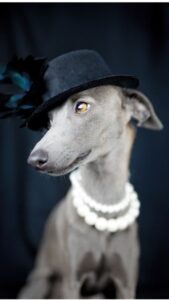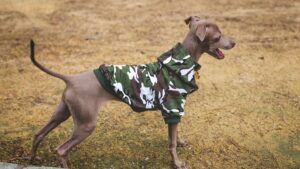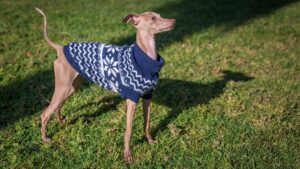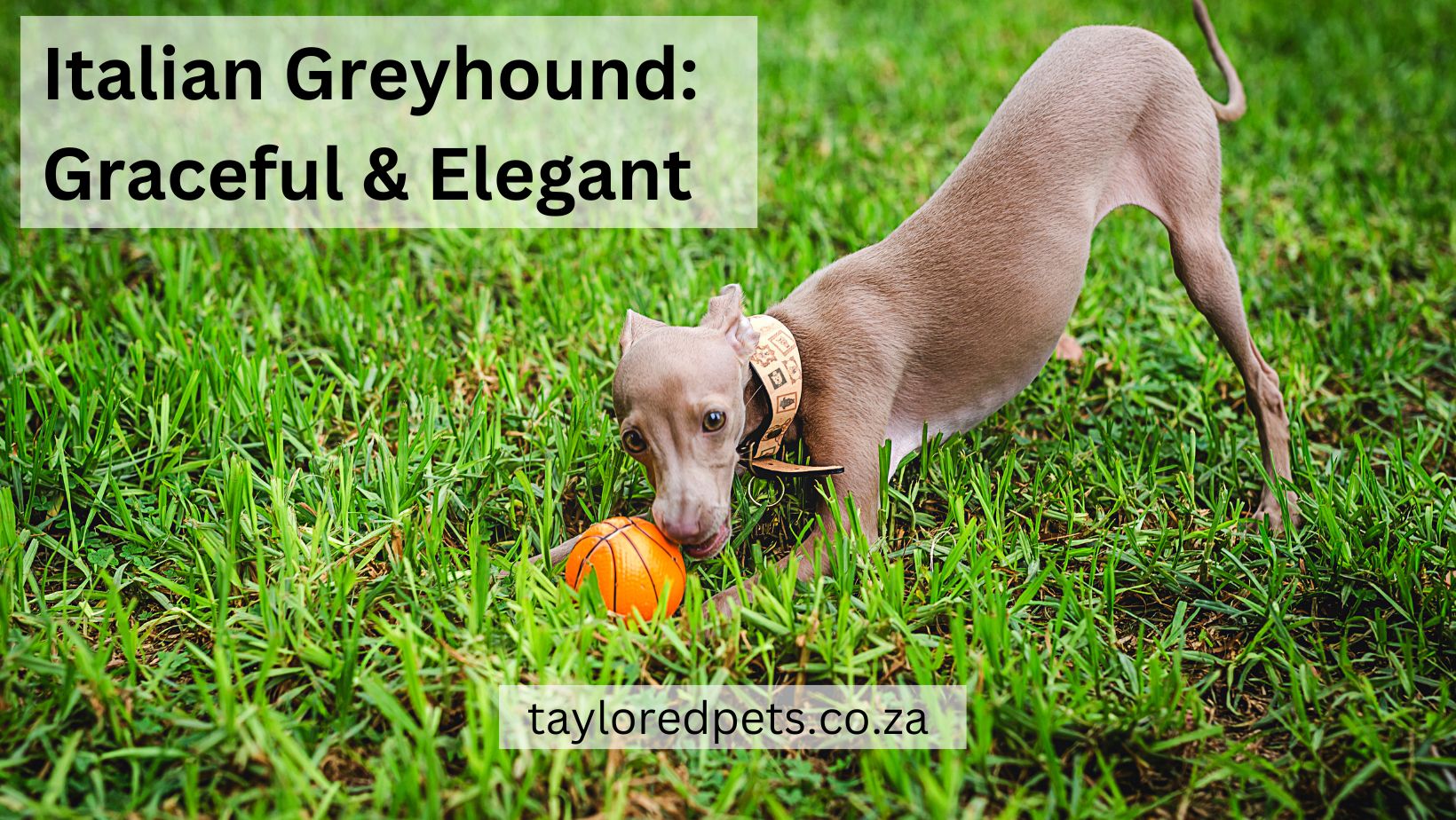
Renowned for its rich cultural heritage and artistic marvels, Italy, is responsible for providing us with a breed of dog that truly embodies grace and elegance – the Italian Greyhound. A petite and slender canine is the Italian Greyhound. It truly is a sight to behold. You can expect its sleek coat, gentle demeanor, and athletic prowess. Join me as we delve into the fascinating world of the Italian Greyhound breed. We will explore their history, temperament, care requirements, and why they make such delightful companions.
A Brief (& Fascinating) History:

The Italian Greyhound, is also known as the Piccolo Levriero Italiano. The history of the Italian Greyhound stretches back over 2,000 years. They are believed to be descendants of small Greyhound-like dogs from ancient Egypt and Greece. Apparently, these elegant creatures were cherished by royalty and aristocracy throughout history. No small wonder considering how beautiful they are, in looks and nature. The Italian Greyhound gained immense popularity during the Renaissance, particularly in Italy. Numerous artworks of the Renaissance era have depictions of this gorgeous breed.
Appearance and Physical Traits:

Italian Greyhounds are small to medium-sized dogs. They typically weigh between 6 to 15 pounds (2.7 to 6.8 kg) and height-wise, they stand about 13 to 15 inches (33 to 38 cm) tall at the shoulder. They have a graceful build, with long, slender legs and a slim, streamlined body. Their coat is fine and comes in a variety of colors. Colours include solid shades and combinations such as blue, black, fawn, red, and cream.
Gentle Temperament:

In keeping with their delicate appearance, Italian Greyhounds are very affectionate and gentle. Known for their sensitive and loyal nature, this breed forms strong bonds with their humans. Italian Greyhounds thrive on companionship and enjoy being showered with attention. That said, they may be reserved with strangers to start out but they tend to warm up quickly, making friends easily – proper socialization.
Exercise and Mental Stimulation:

Despite their slight build, Italian Greyhounds are true athletes. This means they require regular exercise to keep them healthy and happy. You would need to allow for daily walks and playtime in a securely fenced area as these are essential to provide them with a way to expend their energy.
As this breed is extremely fast and very inquisitive, please ensure that any off-leash area is well secured. Losing your Italian Greyhound out on a walk would be heartbreaking – and can very easily happen.
Something important to remember is that Italian Greyhounds have thin skin and little body fat, which makes them more susceptible to the cold. Your budget will need to provide a cozy dog jacket during colder months.
Training and Socialization:

Intelligent and eager to please are Italian Greyhounds. This makes them receptive to training. As they can also be very sensitive by nature, positive reinforcement training techniques work best. As with most (if not all breeds), early socialization is extremely important to give them the best opportunity to develop into well-rounded dogs. The best way to boost their confidence is to expose them to various people, animals, and environments from a young age.
Care and Maintenance:

With their short coat, Italian Greyhounds are low-maintenance and require no grooming. They will need brushing to remove loose hair of course, plus occasional bathing is best to keep them looking as gorgeous as only they can. As can be expected, dental care, nail trimming, and ear cleaning are important to their overall hygiene.
As the Italian Greyhound has thinner skin than most canines, they are prone to injuries and should be handled with care. If your Italian Greyhound is a family pet, please ensure that your children of all ages understand that rough play can result in injury.
Health Considerations:

Whilst generally a healthy breed, Italian Greyhounds can be predisposed to certain health issues. Areas to keep an eye on are their dental health, their knees (patellar luxation/knee dislocation), a possible degenerative eye disease (progressive retinal atrophy), and allergies.
You can keep these potential challenges in check with regular visits to the veterinary clinic, a balanced diet, and safe environment. Responsible breeders are known to conduct health screenings to minimize the risk of inherited conditions, in other words, keep your distance from puppy mills, please.
As big supporters of Adopt Don’t Shop it would be remiss of us to not remind you that there are Italian Greyhound Rescue organizations all over the world. If this is a breed that appeals to you, please also consider contacting the Rescues to see if they have your future companion in their care.
Is An Italian Greyhound A Good Family Pet?

Yes, under the right circumstances, Italian Greyhounds can make a good family pet. Here are a few factors to consider:
- Italian Greyhounds are known to be gentle and affectionate in nature. They can form strong bonds with their human family and enjoy being part of family activities.
- Italian Greyhounds are physically and mentally sensitive dogs. A family with young children who may inadvertently be rough with their pet, would not be the best choice. With any breed, It’s important to teach children how to interact with the dog respectfully and gently.
- As this breed has a delicate build and thin skin, they are more prone to injuries when compared to sturdier breeds. Your Italian Greyhound should be handled with care, this includes close supervision when interacting with young children and larger pets to prevent accidents.
- Moderate exercise needs are required. Daily walks and playtime are perfect for the Italian Greyhound. They are not typically very high-energy dogs, but it is important to ensure regular exercise to prevent weight gain. Obesity can lead to health issues (as with humans too).
- Intentional socialization is crucial for Italian Greyhounds. This is to ensure they feel confident in different situations. It is very important to expose them to different people, animals, and environments from young as this will help them develop good social skills.
- Italian Greyhounds need companionship and human interaction. This breed is not typically suited for families that are away for extended periods of time or are unable to provide them with the attention and affection they require.
- Your lifestyle, the ages of your children, and your ability and availability to provide the care, attention and exercise an Italian Greyhound needs will dictate whether a pup of this breed is suitable for your family. A good recommendation is to spend time with the breed, interact with individual dogs, and consult with reputable breeders or rescue organizations to make an informed decision. It is a 13 to 15-year commitment after all.
How Many Italian Greyhounds Should We Get?

Italian Greyhounds can thrive as single pets and in homes with other dogs. There are a few considerations to keep in mind
when deciding whether to have one or multiple Italian Greyhounds though, here they are:
Companionship: Italian Greyhounds are social and they enjoy the company of humans and other dogs. If your work requires 8 hours plus a day away from home, long hours away from home, having two Italian Greyhounds can provide companionship which could prevent loneliness and boredom.
Play and Exercise: Having more than one Italian Greyhound can ensure that there is a playmate, which can provide additional stimulation and exercise. Together they can engage in interactive play and burn off energy. This could be especially beneficial if you have busy periods and limited time for exercise.
Pack Dynamics: Like many other dog breeds, Italian Greyhounds, have a pack mentality. Having more than one means they can form a close-knit pack within your family. This can result in a sense of security, increased confidence and also strengthen their bond with each other.
Compatibility: Please always consider the personalities and compatibility of the dogs involved. This applies whether both dogs are the same breed or another breed is in the mix. If you are bringing in a new dog to an environment where there is already a family dog in place, please do this with careful consideration, proper introductions, and monitoring to ensure a harmonious process and future in the family.
Cost and Responsibility: It goes without saying that owning multiple dogs means increased costs and responsibilities. Provision of additional food, veterinary care, grooming (though limited with this breed), and attention to multiple Italian Greyhounds will be your responsibility. Please assess your availability and capacity to meet the needs of multiple dogs prior to making a decision.
As is evident above, the decision of whether to have one or multiple Italian Greyhounds should be based on more than one factor – your lifestyle, available time, resources, and the individual needs of the dogs. There are Italian Greyhounds who thrive as the only pet in a household. Then there are others who may benefit from having a companion.
Where Do Italian Greyhounds Sleep?


Due to their short coat and thin skin, Italian Greyhounds are not “outside dogs”. Please ensure you provide for a lovely warm bed inside your home.
This breed also enjoys sleeping (about 18 hours per day) so it’s a good idea to have their bed in a social area of the house, this way they can be “part of the action: even when sleeping.
Do Italian Greyhounds Bark A Lot?

Whilst this is a very sensitive and gentle breed, they are not typically barkers. Your Italian Greyhound will let you know when a stranger is approaching with some barking, more than that would be rare.
Can Italian Greyhounds Be Left Alone?

It is not recommended to leave your Italian Greyhound alone for extended periods of time. One to two hours at the most. This breed does not enjoy being left alone and you can expect separation anxiety and hyperactivity to develop if this does happen.
Are Italian Greyhounds Good Guard Dogs?

As mentioned above, this breed will bark when a stranger is in your midst, that is the full extent of what can be expected from your Italian Greyhound from a protection perspective. It would be unfair to expect this gentle and somewhat delicate breed to become a guard dog, though you can expect a reliable little watchdog to alert you to danger.
How Long Do Italian Greyhounds Live?

With good veterinary care, healthy food, exercise, and a nurturing family environment, Italian Greyhounds can be expected to have a lifespan of between 13 to 15 years.
Conclusion:
I am sure you will agree that the Italian Greyhound is a captivating breed. The combination of elegance, affection, and athleticism in a such small package is enchanting. Their graceful appearance, gentle temperament, and devoted nature make them exceptional companions for individuals and families alike.
As you’ve seen, however, it’s important to consider their exercise needs, fragility, and sensitivity when it comes to the decision of whether to bring one into your life. It is evident that with the proper care, training, and socialization, an Italian Greyhound will fill your home with love, beauty, and a touch of Italian charm.
We truly hope this article has helped you gain more insight into this beautiful breed. Honestly, after doing the research and writing about the Italian Greyhound, I (Louise) am extremely tempted. Then again, a gentle soul with our highly energetic and somewhat demanding Jackie Rascal (all 15 years old of her) may not be the best match.
If you have any questions or contributions to make, please pop in the in the comment section below.
Love always
Louise and Beth
🧡🐾🧡🐾

Wow, what an informative and engaging blog post about Italian Greyhounds! I thoroughly enjoyed reading every word and learning about the unique characteristics of this beautiful breed. The detailed description of their elegant physique, graceful movements, and affectionate nature truly captivated me.
I was particularly fascinated by the section highlighting the Italian Greyhound’s intelligence and trainability. It’s impressive to know that they excel in various activities, such as obedience, agility, and even therapy work. This versatility is certainly appealing to someone like me who loves dogs.
Thanks for sharing
Alex
Hi Alex
Like you, I fell in love with this breed as I researched and learned more about them. They truly are gorgeous pups!
Thank you for stopping by for a visit and a comment.
My sister is interested in getting one. But, she is unsure if she should get one or a Labrador, Italian Greyhound, or a German Shepard.
On my god, these dogs are so artistic. I understand that they are considered to be medium-sized dogs. But, aren’t greyhounds considered to be larger dogs? Perhaps that is a different breed of a greyhound that is larger.
Also, since they are thin dogs does that mean they don’t eat as much as other dogs?
Hi Garen
The three breeds you mention are all so different from each other. It really does depend on what kind of home your sister has to offer and also what her own lifestyle is like. All three breeds you mention need exercise and mental stimulation so your sister will need to have an active lifestyle with a secure garden. If she is looking for more of a lap dog, I would recommend the Italian Greyhound. If she is looking for a more robust companion, the Labrador or German Shepherd would be more suitable options.
So interesting you ask about the size of the Italian Greyhound. This particular dog is definitely smaller than the Greyhound. I will write an article about the Greyhound and create some kind of comparison between the two for you to see the difference.
The Italian Greyhound’s food requirement is half a cup of high calorie, nutritious and good quality dog food twice per day. This breed is high energy so burns off whatever they consume. Being slight in build, it is important to not overfeed them. If we compare the Italian Greyhound too the Greyhound, the Italian Greyhound does not eat as much as a Greyhound.
Hope this answers your questions.